
How To Make Potica (Slovenian Walnut Rolls)
Servings: 12 slices
Calories: 352kcal
Learn how to make this traditional Slovenian festive sweet yeasted roll stuffed with walnut and aromatic spices in the filling that is often served during Easter and Christmas. You can bake it in a loaf pan or in a Bundt pan.
Print Recipe
Ingredients
For the dough:
- 270 g all-purpose flour plus more as needed
- ½ tsp salt
- 2 tsp instant yeast
- 60 g butter melted
- 30 g sugar
- 100 g whole milk start with this amount
- 50 g egg from 1 large egg
For the filling:
- 225 gr roasted walnuts or you can use pecans or mixture of both
- ½ tsp salt
- 1 tsp ground cinnamon
- 85 gr honey
- 60 gr light brown sugar
- 2 Tbsp butter unsalted, melted
- 1 tsp vanilla extract
- 50 g egg separate the yolk from the white
- 2 tsp cocoa powder optional (I didn't use)
- milk if needed
- 1 egg white beaten, for brushing the dough
For brushing the loaf:
- 1 large egg
- 1 Tbsp water
- pinch of salt
For topping (if baking in the loaf pan):
- 40 gr turbinado sugar
Instructions
Prepare the filling:
- Toast the walnuts on a dry non-stick pan over medium-low heat until they smell nutty and nice, about 5 minutes. Let it cool down completely when you prepare other things
- Put the toasted walnuts in a food processor and pulse several times until they are in fine pieces, almost like coarse flour consistency. Don't overwork it so it won't turn into walnut butter

- Separate the egg yolk from the white. Add the egg yolk and the rest of the ingredients to the walnut. Stir to combine evenly. Use a fork and beat the egg white vigorously until they are foamy. Fold the egg white into the walnut mixture. It should be thick but moist enough for you to spread on the dough later. Cover and set aside
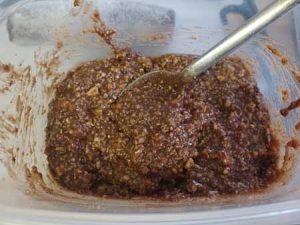
Prepare the dough:
- Put all the ingredients for the dough in a mixing bowl of a stand mixer fitted with a hood attachment. I usually use the hook to stir the ingredients a bit to combine so when I start the machine, the dry ingredients won't "fly" all over
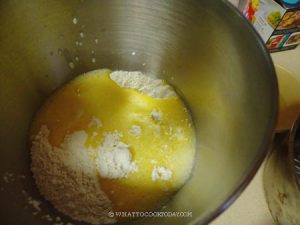
- Start with the lowest speed for about 2-3 minutes to get a rough shaggy dough and then increase the speed to 4 (on KA) and knead for 8-10 minutes. You need to stop the machine several times to scrape the dough from the side of the bowl so everything is kneaded properly. Knead the until dough is smooth and elastic. It should be sticky too the touch but won't stick to your fingers.
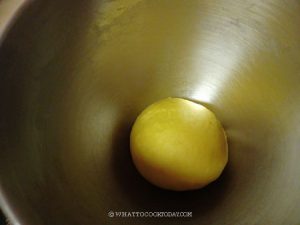
First proofing:
- Lightly oil the bowl. Cover the dough and let it rise at a warm place for about one hour or until it doubles in volume. This may take 1 hour or longer, depending on the temperature
To bake in loaf pan:
- Grease a 9 x 5 inch loaf pan and the line the pan with a parchment paper. You can crisscross with parchment paper
- Lightly dust your work surface with a bit of flour. Turn the dough out onto the working surface. Use a rolling pin to gently roll the dough out (while deflating some air bubbles at the same time) into about 18 x 24 inch rectangles, with the long side near you. The dough will be quite thin, about 1/8 inch in thickness is ideal
- Pro tips: Beat another egg white in a bowl to loosen. Brush rolled dough with beaten egg white before spreading filling. This is to prevent the filling from separating from the filling after baking
- Very gently and carefully spread the filling on the surface of the dough leaving about 1/2 inch along the borders. The filling should be easily spread without tearing the dough. If it's too thick, add 1 tablespoon of milk (or more as needed) to the walnut filling to thin it out a bit and try to spread again.
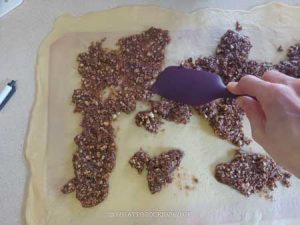
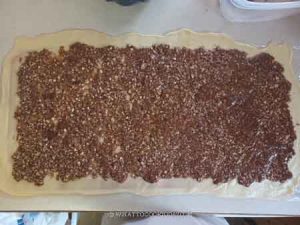
- Carefully roll the dough up, starting from the side near you, moving along the length of the dough. Tuck it in as you roll so it will be a tight log and you won't end up with the filling and the dough "separating" when you cut into the bread later after baking. The seam side should be facing down. Pinch the seams together with your fingers to seal
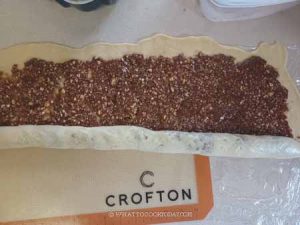
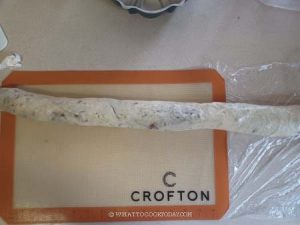
- Gently roll the dough back and forth in the middle part of the log, then move to the left and do the same and move to the right and do the same.This is to lengthen the log a little bit, so it is about 3 times the length of your baking pan. Pinch the dough on both ends to seal.
- Shape the log into a "Z" shape and carefully lift the dough up and put it inside the pan. The dough shouldn't be stacking on top of each other. It should be a "Z" shape inside the pan too
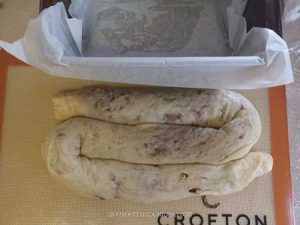

If baking in a Bundt pan:
- This recipe will fit into 8 x 2 3/4-inch Bundt pan (6 cups/1.4 litre). Generously butter the pan, especially the nook and cranny parts and then dust with flour. Tapping out any excess flour. You can also use a non-stick spray with flour such as Baker's Joy.
- Helpful tips: Use a clean kitchen towel and roll it into a log and place this inside your bundt pan, pretending that this is the dough you are going to bake. This helps to "measure" how long you need to roll the dough out so the dough fit nicely into the bundt pan without being too long
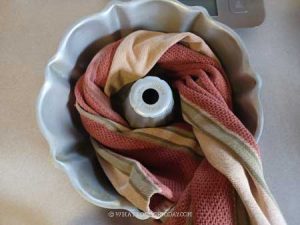
- Use a rolling pin to gently roll the dough out (while deflating some air bubbles at the same time) into the length as long as the towel you use to measure the Bundt pan, you can roll it slightly longer than the towel, with the long side near you
- Very gently and carefully spread the filling on the surface of the dough leaving about 1/2 inch along the borders. The filling should be easily spread without tearing the dough. If it's too thick, add 1 tablespoon of milk (or more as needed) to the walnut filling to thin it out a bit and try to spread again.

- Carefully roll the dough up, starting from the side near you, moving along the length of the dough. Tuck it in as you roll so it will be a tight log and you won't end up with "holes" when you cut into the bread later after baking. The seam side should be facing down. Pinch the seams together with your fingers to seal
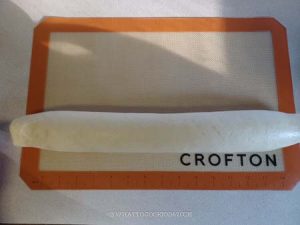
- Lift the dough up and gently place this inside the Bundt pan, pinching the two ends to seal it together the best you can
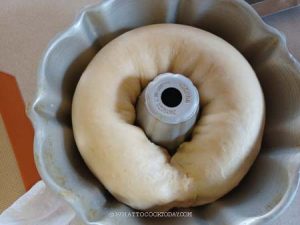
Second proofing:
- Cover the shaped dough and put in a warm place to let the dough rise again until it doubles the size again, about an hour or so, depending on the temperature where you are
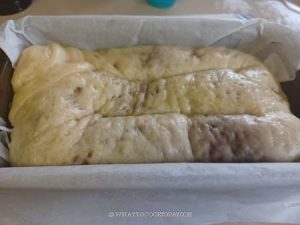
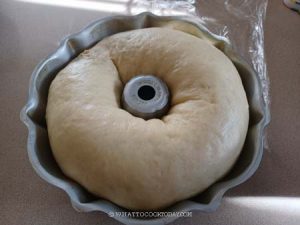
Baking:
- Beat the egg with water to make an egg wash
- 10 minutes before the end of second proofing, preheat oven to 350 F (180 C). This is for conventional oven with bottom heat only. If you use convection oven, you may want to lower temperature by 20 F/15 C
- Brush the surface of the dough with egg wash. if you bake in a bundt pan, poke a few holes on top to help release some hot air.

- If you bake in a loaf pan, sprinkle with some turbinado sugar (or regular sugar) and some chopped walnuts and/or pecans (totally optional_
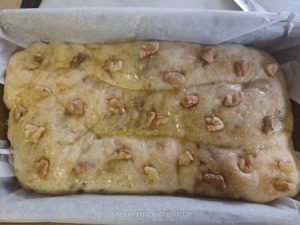
- Place the pan at the middle rack and bake for 15 minutes. Lower the temperature to 300 F (150 C) for conventional oven, without opening the oven door, and bake for another 45 minutes or until the internal temperature of the bread is 190 F ( 88 C)Lower the temperature by 20 F/15 C for convection oven
- Remove from the oven and let the bread cool down in the pan on a cooling rack for about 15 minutes and then remove from the pan and let it cool down completely on a cooling rack
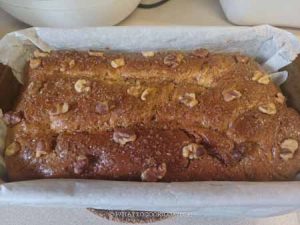
Serve the next day:
- The bread tastes even better the next day when the flavor has fully developed
How to store:
- Once the bread has cooled down completely, wrap it up with a cling wrap and keep inside an air-tight container and it can be kept at room temperature for about 3 days
- For longer storage, keep them in the freezer. Wrap it well with a cling wrap and then put inside a freezer bag, push all the air out and seal. Keep in the freezer for about one month. Simply thaw at room temperature before serving
Video
Nutrition
Serving: 1serving | Calories: 352kcal | Carbohydrates: 38g | Protein: 8g | Fat: 20g | Saturated Fat: 6g | Polyunsaturated Fat: 9g | Monounsaturated Fat: 4g | Trans Fat: 0.2g | Cholesterol: 63mg | Sodium: 288mg | Potassium: 170mg | Fiber: 3g | Sugar: 18g | Vitamin A: 270IU | Vitamin C: 0.3mg | Calcium: 48mg | Iron: 2mg